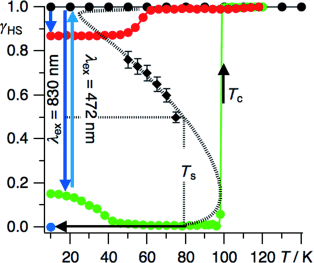-
Light Induced Bistability in the 2D Coordination Network {[Fe(bbtr)3](BF4)2}∞: Wavelength-Selective Addressing of Molecular Spin States
P. Chakraborty, S. Pillet, E.-E. Bendeif, C. Enachescu, R. Bronisz and A. Hauser
Chemistry - A European Journal, 19 (34) (2013), p11418-11428


DOI:10.1002/chem.201301257 | unige:29524 | Abstract | Article PDF

Whereas the neat polymeric Fe(II) compound {[Fe(bbtr)3](ClO4)2}∞ (bbtr=1,4-di(1,2,3-triazol-1-yl)butane) shows an abrupt spin transition centered at 107 K facilitated by a crystallographic symmetry breaking, in the covalently linked 2D coordination network of {[Fe(bbtr)3](BF4)2}∞, Fe(II) stays in the high-spin state down to 10 K. However, strong cooperative effects of elastic origin result in reversible, persistent and wavelength-selective photoswitching between the low-spin and high-spin manifolds. This compound thus shows true light-induced bistability below 100 K. The persistent bidirectional optical switching behavior is discussed as a function of temperature, irradiation time and intensity. Crystallographic studies reveal a photo-induced symmetry breaking and serve to establish the correlation between structure and cooperative effects. The static and kinetic behavior is explicated within the framework of the mean-field approximation.